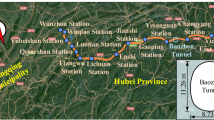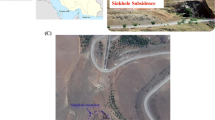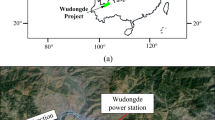Abstract
Diversion tunnels are important structures for hydropower projects but are always placed in locations with less favorable geological conditions than those in which other structures are placed. Because diversion tunnels are usually large and closely spaced, the rock pillar between adjacent tunnels in weak rocks is affected on both sides, and conventional support measures may not be adequate to achieve the required stability. Thus, appropriate reinforcement support measures are needed, and the design philosophy regarding large parallel tunnels in weak rocks should be updated. This paper reports a recent case in which two large parallel diversion tunnels are excavated. The rock masses are thin- to ultra-thin-layered strata coated with phyllitic films, which significantly decrease the soundness and strength of the strata and weaken the rocks. The behaviors of the surrounding rock masses under original (and conventional) support measures are detailed in terms of rock mass deformation, anchor bolt stress, and the extent of the excavation disturbed zone (EDZ), as obtained from safety monitoring and field testing. In situ observed phenomena and their interpretation are also included. The sidewall deformations exhibit significant time-dependent characteristics, and large magnitudes are recorded. The stresses in the anchor bolts are small, but the extents of the EDZs are large. The stability condition under the original support measures is evaluated as poor. To enhance rock mass stability, attempts are made to reinforce support design and improve safety monitoring programs. The main feature of these attempts is the use of prestressed cables that run through the rock pillar between the parallel tunnels. The efficacy of reinforcement support measures is verified by further safety monitoring data and field test results. Numerical analysis is constantly performed during the construction process to provide a useful reference for decision making. The calculated deformations are in good agreement with the measured data, and the calculated forces of newly added cables show that the designed reinforcement is necessary and ensures sufficient stability. Finally, the role of safety monitoring in the evaluation of rock mass stability and the consideration of tunnel group effect are discussed. The work described in this paper aims to deepen the understanding of rock mass behaviors of large parallel tunnels in weak rocks and to improve the design philosophy.
























Similar content being viewed by others
References
Blake W, Hedley DG (2003) Rockbursts: case studies from North American hard-rock mines. Society for Mining, Metallury, and Exploration, Inc. (SME), Littleton, Colorado, USA
Chen BR, Feng XT, Li QP, Luo RZ, Li S (2015a) Rock burst intensity classification based on the radiated energy with damage intensity at Jinping II hydropower station, China. Rock Mech Rock Eng 48(1):289–303
Chen M, Lu WB, Zhang WJ, Yan P, Zhou CB (2015b) An analysis of consolidation grouting effect of bedrock based on its acoustic velocity increase. Rock Mech Rock Eng 48(3):1259–1274
Diederichs MS (2003) Manuel Rocha medal recipient rock fracture and collapse under low confinement conditions. Rock Mech Rock Eng 36(5):339–381
Egger P (2000) Design and construction aspects of deep tunnels (with particular emphasis on strain softening rocks). Tunn Undergr Space Technol 15(4):403–408
Goel RK, Jethwa JL, Paithankar AG (1995) Tunnelling through the young Himalayas—a case history of the Maneri-Uttarkashi power tunnel. Eng Geol 39(1):31–44
Hasanpour R, Rostami J, Barla G (2014) Impact of advance rate on entrapment risk of a double-shielded TBM in squeezing ground. Rock Mech Rock Eng 48(3):1115–1130
Hatzor YH, Wainshtein I, Mazor DB (2010) Stability of shallow karstic caverns in blocky rock masses. Int J Rock Mech Min Sci 47(8):1289–1303
Hoek E, Guevara R (2009) Overcoming squeezing in the Yacambú-Quibor tunnel, Venezuela. Rock Mech Rock Eng 42(42):389–418
Hoek E, Marinos P (2000) Predicting tunnel squeezing problems in weak heterogeneous rock masses. Tunn Tunn Int 32(11):45–51
Høien AH, Nilsen B (2014) Rock mass grouting in the Løren tunnel: case study with the main focus on the groutability and feasibility of drill parameter interpretation. Rock Mech Rock Eng 47(3):967–983
Hsu SC, Chiang SS, Lai JR (2004) Failure mechanisms of tunnels in weak rock with interbedded structures. Int J Rock Mech Min Sci 41(3):670–675
Hu ZF, Yue ZQ, Zhou J, Tham LG (2003) Design and construction of a deep excavation in soft soils adjacent to the Shanghai Metro tunnels. Can Geotech J 40(5):933–948
Lin HI, Lee CH (2009) An approach to assessing the hydraulic conductivity disturbance in fractured rocks around the syueshan tunnel, Taiwan. Tunn Undergr Space Technol 24(2):222–230
Malan DF (1999) Time-dependent behaviour of deep level tabular excavations in hard rock. Rock Mech Rock Eng 32(2):123–155
Manh HT, Sulem J, Subrin D, Billaux D (2015) Anisotropic time-dependent modeling of tunnel excavation in squeezing ground. Rock Mech Rock Eng 48(6):2301–2317
Panarace M, Garnil C, Cané L, Rodríguez E, Medina M (2012) Identification, remediation, and analysis of karst sinkholes in the longest railroad tunnel in South Korea. Eng Geol 135–136(7):92–105
Singh TN, Kainthola A, Venkatesh A (2012) Correlation between point load index and uniaxial compressive strength for different rock types. Ann Rheum Dis 45(2):1–6
Steiner DW (1996) Tunnelling in squeezing rocks: case histories. Rock Mech Rock Eng 29(29):211–246
Suorineni FT, Kaiser PK, Henning JG (2008) Safe rapid drifting–support selection. Tunn Undergr Space Technol 23(6):682–699
The National Standards Compilation Group of the People’s Republic of China (2015a) Standard for engineering classification and rock masses (GB/T50218-2014). China Planning Press, Beijing (in Chinese)
The National Standards Compilation Group of the People’s Republic of China (2015b) Technical code for engineering of ground anchorages and shotcrete support (GB/T50086-2015). China Planning Press, Beijing (in Chinese)
Tseng DJ, Tsai BR, Chang LC (2001) A case study on ground treatment for a rock tunnel with high groundwater ingression in Taiwan. Tunn Undergr Space Technol 16(3):175–183
Yang J, Lu W, Hu Y, Chen M, Yan P (2015) Numerical simulation of rock mass damage evolution during deep-buried tunnel excavation by drill and blast. Rock Mech Rock Eng 48(5):2045–2059
Zhang YT, Lu B (2013a) Surrounding rock mass stability analysis and optimization of cable support for right bank diversion tunnels under unfavorable geological conditions at Wudongde hydropower plant (No. II2013292YT). Yangtze River Scientific Research Institute, Wuhan, China (in Chinese)
Zhang YT, Lu B (2013b) Surrounding rock mass stability analysis and check of reinforcement design for right bank diversion tunnels under unfavorable geological conditions at Wudongde hydropower plant (No. II2013294YT). Yangtze River Scientific Research Institute, Wuhan, China (in Chinese)
Zhang YT, Wu YJ (2014) Surrounding rock mass stability check on inlet section and tunnel section with unfavorable geological conditions for right bank diversion tunnels at Wudongde hydropower plant (No. II2015025YT). Yangtze River Scientific Research Institute, Wuhan, China (in Chinese)
Zhang GH, Jiao YY, Wang H (2014) Outstanding issues in excavation of deep and long rock tunnels: a case study. Can Geotech J 51(9):984–994
Zhao Y, Li P, Tian S (2013) Prevention and treatment technologies of railway tunnel water inrush and mud gushing in China. J Rock Mech Geotech Eng 5(6):468–477
Acknowledgements
Financial support from the National Natural Science Foundation of China (Nos. 51539002, 51209021, 51379022), the National Key Research and Development Program of China (Nos. 2016YFC0401802, 2016YFC0401803, 2016YFC0401804, 2016YFC0402008), and the Basic Research Fund for the Central Research Institutes of Public Causes (No. CKSF2015041/YT) are greatly acknowledged.
Author information
Authors and Affiliations
Corresponding author
Rights and permissions
About this article
Cite this article
Ding, X., Weng, Y., Zhang, Y. et al. Stability of Large Parallel Tunnels Excavated in Weak Rocks: A Case Study. Rock Mech Rock Eng 50, 2443–2464 (2017). https://doi.org/10.1007/s00603-017-1247-6
Received:
Accepted:
Published:
Issue Date:
DOI: https://doi.org/10.1007/s00603-017-1247-6




